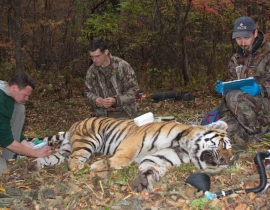Posted November 11, 2013 in All
Colchester Zoo’s charity, Action for the Wild, has been supporting Wildlife Vet International (WVI) for many years. Funds donated have been used to help assess the health of wild and captive Amur leopards and their prey base in the wild. For 2013, they included the Amur tiger into the research, as both cats share the same habitat and are vulnerable to the same diseases, such as the canine distemper virus (CDV).
It has been highlighted by WVI that CDV is a potential killer to tigers in many countries. New major research is currently under way in Russia to help discover how the country’s Amur tigers are contracting this virus.
In the Russian Far East, CDV has been definitively diagnosed in two wild tigers with neurological symptoms and unnatural behaviour. Other clinically similar cases suspicious of CDV in wild Amur tigers have not been confirmed by laboratory testing. A recent scientific paper (Seimon et al, 2013) now confirms CDV as an emerging disease for the Amur tiger and is directly or indirectly responsible for the deaths of approximately 1% of the wild population.
The paper concludes “Our report illustrates the importance of long-term wildlife monitoring and health surveillance in identifying emerging threats in endangered species. Identifying animal reservoirs for CDV and identifying the CDV strains that are transmissible to and among wildlife species, including Amur tigers and Amur leopards, is essential for guiding conservation and mitigation efforts.”
So where has the disease come from – wildlife or pets? Is tiger CDV related to dog CDV at all?
A team of Amur Leopard and Tiger Alliance (ALTA) partners are currently working together to investigate where the reservoir for this disease may be. In the recent paper it was noted that domestic dogs and wildlife, such as raccoon dogs, were the most likely disease reservoirs. There is little evidence to suggest transmission between tigers, and tigers are known to encounter and kill domestic dogs.
The first phase of investigation involved trapping and testing small wild carnivores in tiger and leopard habitat. The next phase focused on domestic pets surrounding the newly created national park; the ‘Land of the Leopard’. Pet owners were interviewed and blood and nasal samples were taken from 200 dogs and cats. Pet owners were asked about previous animals they had owned, and whether they had suffered from any diseases, including diseases with symptoms similar to canine distemper.
This is important research and information gathered will allow a greater understanding of significant disease threats to the Amur tiger and Amur leopard.
Picture of Dr John Lewis checking an Amur tiger © John Lewis.



